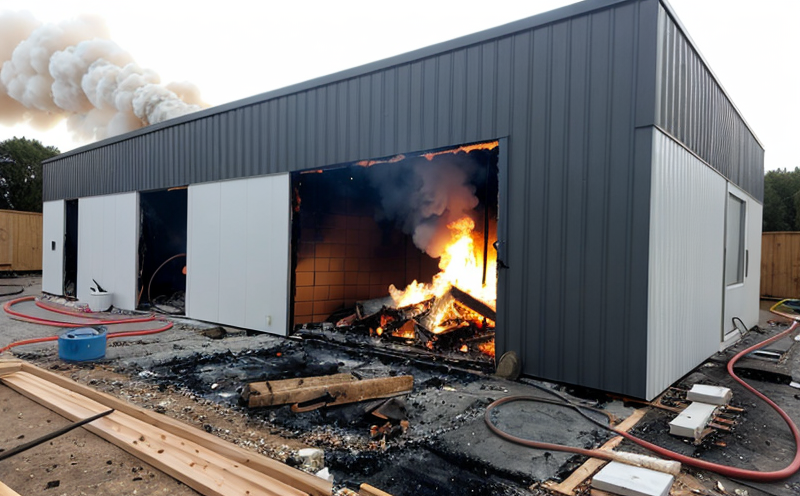Reaction-to-Fire Testing for Laminated Insulation Boards
The reaction-to-fire (RFT) testing of laminated insulation boards is a critical process in ensuring the safety and compliance with fire safety regulations. This testing evaluates how materials react when exposed to high temperatures, flame impingement, or other fire-related stimuli. The purpose is to assess not only the combustibility of the material but also its potential to contribute to the spread of fire within structures.
Laminated insulation boards are widely used in various industries, including construction and building materials. These materials are often installed as part of a larger assembly (such as cladding or structural components), where their performance during a fire event can significantly impact the overall safety of the structure. The testing aims to determine whether these boards can resist ignition, produce flaming droplets, or release harmful gases under controlled conditions.
According to international standards such as ISO 1716 and ASTM E84, RFT tests are conducted in a standard furnace setup where specimens are subjected to specific heating rates and flame durations. The results of these tests provide valuable insights into the fire behavior characteristics of the material, including smoke production index (SPI), heat release rate (HRR), and the time to ignition.
The testing process involves detailed preparation of the specimen, which is typically cut to standard dimensions for accurate measurement. This includes ensuring that the surface finish and thickness are consistent with industry specifications. The specimens are then placed in a furnace where they undergo exposure to flames under controlled conditions. The performance during this period determines the board's reaction-to-fire rating.
The results of these tests help ensure compliance with fire safety regulations such as those outlined by the National Fire Protection Association (NFPA) and the Building Research Establishment (BRE). Compliance is essential for manufacturers, installers, and end-users to ensure that materials meet stringent safety standards. This testing not only protects against potential fires but also helps in the design of safer buildings.
The importance of this testing cannot be overstated. It plays a crucial role in preventing the spread of fire within structures, which can lead to significant loss of life and property damage. By ensuring that laminated insulation boards meet strict fire safety standards, we contribute to building safer communities. This service is particularly important for those involved in construction projects where fire safety is paramount.
Understanding the parameters involved in RFT testing helps stakeholders make informed decisions regarding material selection and design choices. It provides a clear picture of how materials will perform under real-world conditions, ensuring that they are suitable for use in environments where fire resistance is crucial.
Benefits
- Achieving Compliance: Ensures compliance with international standards and local regulations.
- Informed Decision-Making: Provides essential data for material selection, design, and installation.
- Enhanced Safety: Reduces the risk of fire spread in building assemblies.
- Reputation Building: Demonstrates commitment to quality and safety standards.
Industry Applications
The reaction-to-fire testing for laminated insulation boards is particularly relevant in industries where fire safety is of utmost importance. This includes the construction sector, where these materials are often used as part of building cladding systems or structural components. The testing ensures that the materials perform reliably under fire conditions, contributing to overall building safety.
In the case of buildings with high-rise structures or those located in areas prone to fire hazards, the use of compliant materials is critical. The test results help architects and engineers design safer spaces by selecting appropriate materials that meet stringent fire safety standards. This testing also benefits manufacturers who need to ensure their products comply with regulatory requirements before entering the market.
The findings from these tests are valuable for insurance companies as well, as they can use the data to assess risk levels associated with specific building materials and designs. By providing clear insights into material performance under fire conditions, this service aids in reducing claims due to structural fires.
Eurolab Advantages
EuroLab is committed to delivering high-quality, accurate reaction-to-fire testing services for laminated insulation boards. Our state-of-the-art facilities and experienced team ensure that we meet the highest standards of precision and reliability.
- Expertise: Our team consists of seasoned professionals with extensive experience in fire safety testing.
- Accreditation: We are fully accredited to conduct tests according to international standards, ensuring credibility and accuracy.
- Technology: Utilize advanced equipment for precise measurement and analysis.
- Compliance: Stay up-to-date with the latest regulations and guidelines, providing thorough testing solutions.
The use of these facilities and methodologies guarantees that our clients receive results they can trust. We understand the importance of this testing in ensuring safety and compliance, which is why we invest in maintaining our leading edge capabilities.





